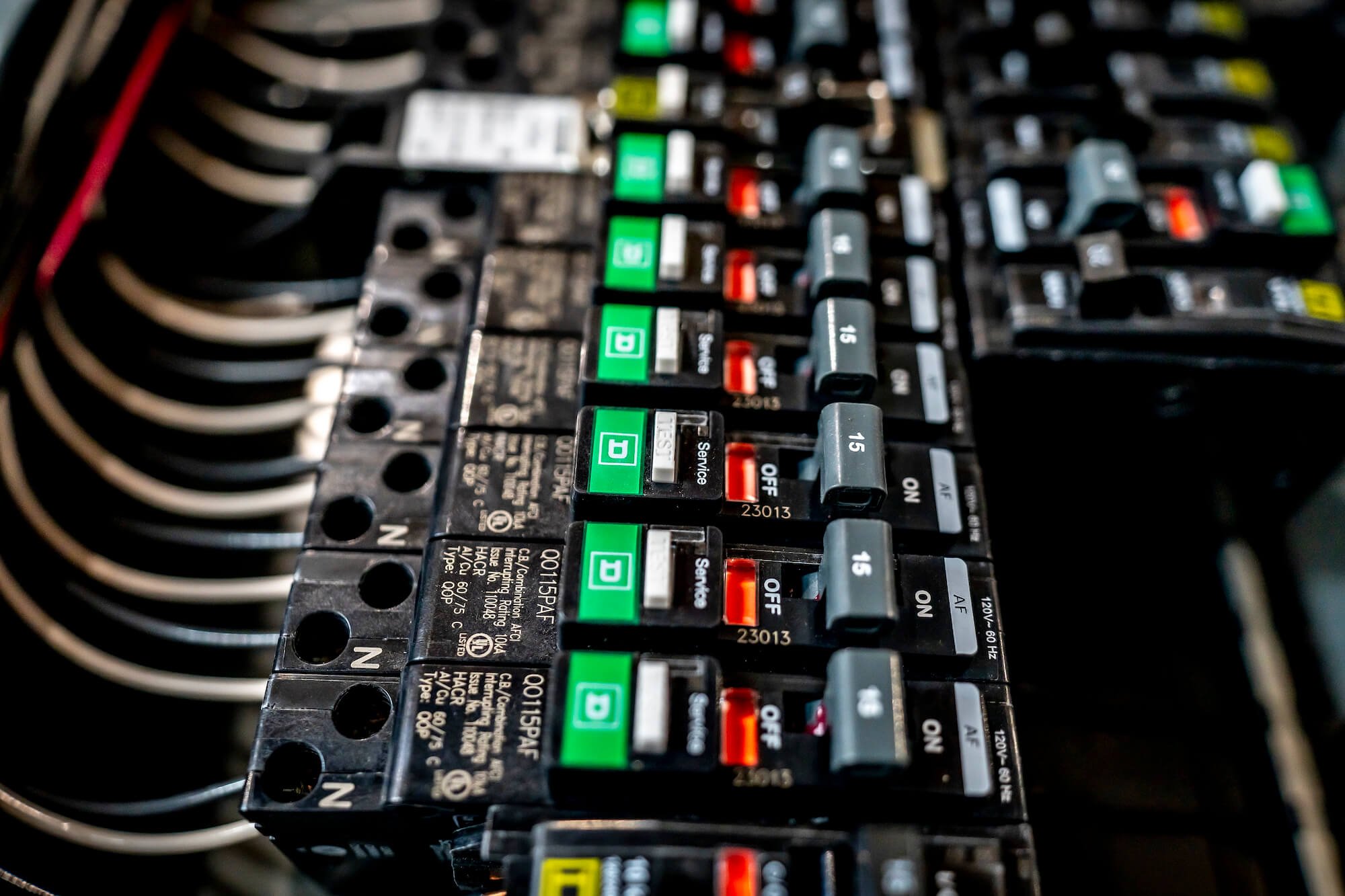
Circuit Interrupters
Circuit Breakers
A circuit breaker is an automatically-operated electrical switch designed to protect an electrical circuit from damage caused by overload or short circuit. Its basic function is to detect a fault condition and, by interrupting continuity, to immediately discontinue electrical flow. Unlike a fuse, which operates once and then has to be replaced, a circuit breaker can be reset (either manually or automatically) to resume normal operation.
Breaker Tips
1.) Please don’t use the area in front of your service panel for storage. Your panel needs to be accessible for servicing with a 3′ working clearance in front of the panel by 30″ in width.
2.) Once a year set all the circuit breakers to the off position. When complete, reset all the breakers to the on position. This procedure ensures proper functioning of the circuit breakers. If you happen to have any GFCI circuit breakers, the above procedure should be done monthly using the test button on the breaker.
3.) If a loss of power is noticed in a certain area of your home, go to your circuit breaker panel. Look in your panel circuit breaker directory for a room name that coincides with a room that lost power. Try to reset that breaker by setting it first to the fully off position and then setting it to the fully on position. If the breaker fails to reset, go unplug any appliances on that circuit and try to reset the breaker again. If the breaker still fails to reset, DO NOT use any of the outlets on that circuit and call James Electrical Contractors.
SCHNEIDER ELECTRIC'S SQUARE D ARC FAULT BREAKERS
We are very ambitious when it comes to the quality of the products we install in your home. That’s why most of the equipment we use comes from Schneider Electric. Their attention to detail and high quality products ensure that all of our work goes exactly as planned.
GFCI Troubleshooting
Test
Push the Test button on your GFCI device and the Reset button will pop out along with the LED indicator turning red. This should result in the power being off for that outlet and all other outlets using that GFCI device. To ensure your safety, use a test lamp on the GFCI device and all other outlets fed by the device to make sure they are off. CAUTION: If the test lamp goes on while checking any of these outlets, DO NOT use any of the outlets on that GFCI circuit and call James Electrical Contractors.
Reset
If the GFCI device as well as all the other outlets (if any) tested out okay (your test lamp remained off), restore power by pushing the Reset button firmly until it locks and remains depressed. If the GFCI fails to reset properly DO NOT use and call James Electrical Contractors.
Diagnose
If a GFCI device trips by itself, reset and perform test procedures A and B above. If the reset button does not depress, unplug all appliances on that GFCI circuit and try to reset again. If GFCI resets properly after this, there is a good chance that the cord from one of your appliances or the appliance itself is defective. If your reset button still doesn’t depress after all appliances are unplugged, DO NOT use any of the outlets and call James Electrical Contractors.
GFCI Tips
1.) All bathroom outlets are on one separate 20 AMP circuit GFCI device, this device is usually located in the master bath and protects all other bath outlets.
2.) All kitchen outlets are on two GFCI devices; these devices are located in the kitchen over your countertops.
3.) Overhead garage door outlets are protected by a GFCI outlet in the garage.
4.) All outlets in unfinished areas or located within six feet from a sink basin are protected by a GFCI. Note: Local codes may provide an exception to some applications such as for a sump pump.
AFCI
An Arc Fault Circuit Interrupter (AFCI) is a circuit breaker designed to prevent fires detecting a non-working (i.e., non-intended / non-useful) electrical arc and disconnect the power before the arc starts a fire. An AFCI should, but may not always, distinguish between a working arc that may occur in the brushes of a vacuum cleaner, on operation of a light switch, on insertion / removal of a plug into an electrical receptacle, or during the operation of other household devices and a non-working arc that can occur, for example a lamp cord that has a broken conductor in the cord from overuse. Arc faults in a home are one of the leading causes for household fires.
Every once in a while an arc fault breaker may trip due to an arc caused by an appliance or other electrical device. If this occurs, reset the breaker. If it continues to happen, contact us and we will help you troubleshoot the problem or schedule a service appointment.
AFCI Tips
If you have recently built a new home wired by James Electric then your home is up to code with Arc-Fault Circuit Interrupter (AFCI) protection based off of the current National Electric Code and the Wisconsin Electrical Code (SPS 316).
Lighting and outlets in areas such as bedrooms, living rooms, dining rooms, hallways, closets and the like are protected with AFCI breakers.
AFCI breakers are designed to be highly sensitive to even small anomalies in the electrical waveform. This sensitivity allows them to detect arcing conditions that might go unnoticed by traditional thermal-magnetic circuit breakers. However, this sensitivity can also lead to more frequent tripping when minor arcing occurs, such as that caused by appliances with motors, electronic devices, or occasional electrical noise.
Appliance manufacturers are expected to test their equipment with all makes and brands of breakers. Occasionally, some appliance brands will sell equipment that’s internal components under normal operation cause a healthy arc-fault breaker to trip.
Contact
24 Enterprise Road Suite F Delafield, WI 53018
Phone: (262) 646-2219
Fax: (262) 646-2662





